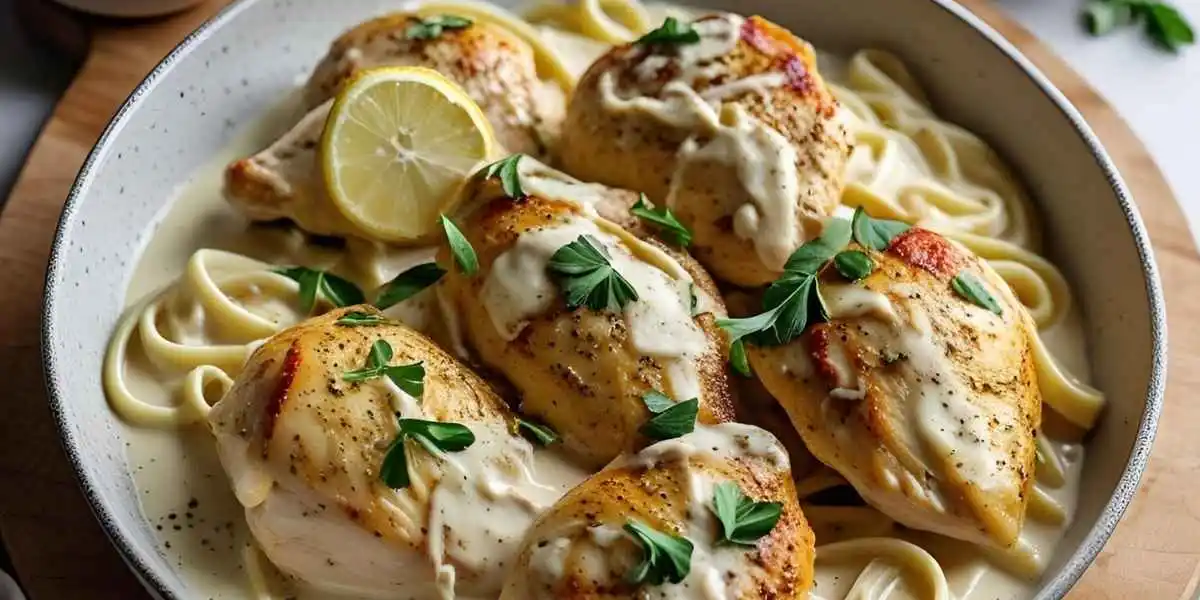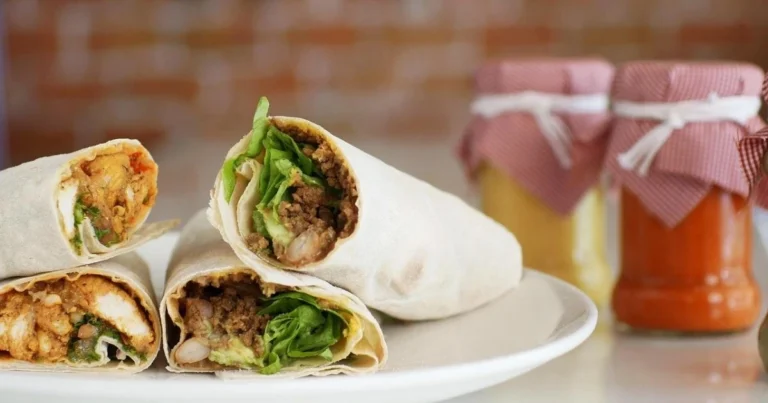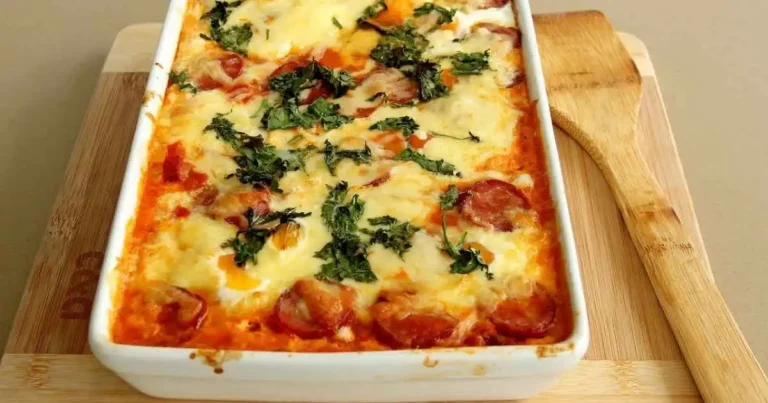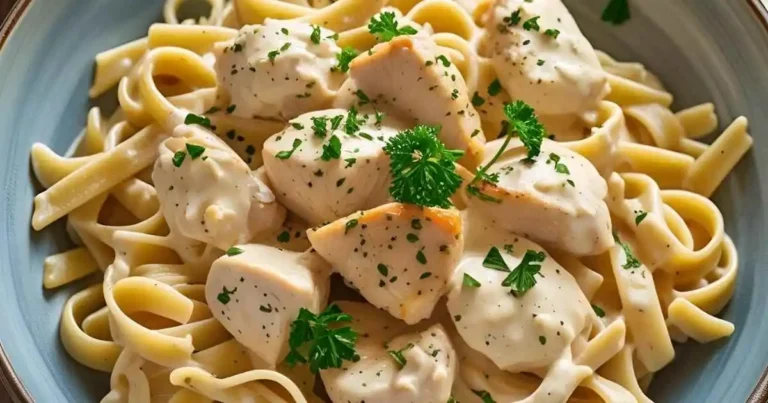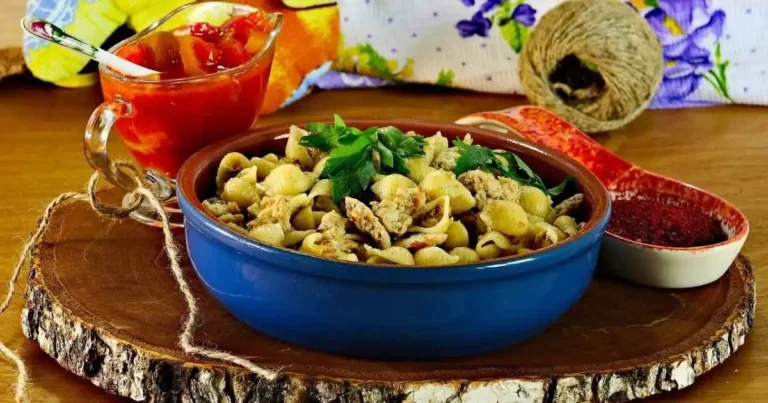Easy Chicken Alfredo Recipe for Creamy Fettuccine Pasta
Table of Contents
Learn how to make chicken alfredo and indulge in the rich flavors of Italy with a dish that’s both simple to prepare and impressively delicious. Fettuccine pasta, with its smooth texture, pairs perfectly with a creamy sauce, making it a staple for home cooks. This classic chicken alfredo recipe is loved for its ease and the comfort it brings to any meal.
You can create a mouth-watering fettuccine chicken alfredo sauce with just a few ingredients, elevating your pasta game. This recipe is ideal for a quick weeknight dinner or a special occasion, offering a delightful culinary experience without the complexity.
Key Takeaways
- Quick and easy preparation
- Creamy fettuccine pasta dish
- Perfect for weeknight dinners or special occasions
- Simple ingredients for a rich flavor
- Comforting meal for any time
The History and Appeal of Chicken Alfredo
As you indulge in the creamy goodness of Chicken Alfredo, you’re experiencing a culinary evolution that has its roots in Italy. The original dish, Fettuccine Alfredo, was created in the early 20th century by Alfredo Di Lelio. Initially, it was a simple yet rich combination of fettuccine pasta, Parmesan cheese, and butter.
Origins of Fettuccine Alfredo
Fettuccine Alfredo was first made famous in Rome, Italy, as a dish to please Di Lelio’s wife, who was recovering from childbirth. The original recipe was straightforward, relying on high-quality ingredients for its flavor. The simplicity and richness of the dish made it an instant hit.
How the Dish Evolved in American Cuisine
As Italian immigrants brought their culinary traditions to America, Fettuccine Alfredo underwent a transformation. To make it more substantial, chicken was added, thus creating Chicken Alfredo. This adaptation not only catered to American tastes but also elevated the dish to a main course status. Today, when you learn how to make chicken alfredo, you’re participating in a culinary tradition that blends Italian simplicity with American heartiness.
- The addition of chicken made the dish more filling and satisfying.
- American preferences for richer sauces led to the incorporation of heavy cream.
- The versatility of Chicken Alfredo has made it a staple in many American households.
Understanding the history behind Chicken Alfredo enriches your appreciation of the dish. Whether you’re cooking for yourself or others, knowing the origins and evolution adds a layer of depth to your culinary experience.
Essential Ingredients for Authentic Chicken Alfredo
When it comes to making Chicken Alfredo, the ingredients you choose are crucial. The dish’s authenticity and flavor profile heavily rely on the quality and type of ingredients used.
Selecting the Right Pasta
For an authentic Chicken Alfredo, you’ll need fettuccine pasta. This flat, wide noodle made from egg and flour is the traditional choice because its smooth surface allows the creamy Alfredo sauce to cling to it perfectly.
Choosing Quality Chicken
Boneless, skinless chicken breasts are the preferred choice for Chicken Alfredo. They provide a lean protein source that cooks evenly and quickly.
Dairy Components for the Perfect Sauce
The sauce is where the magic happens, and it’s all about the dairy. You’ll need high-quality butter, heavy cream, and Parmesan cheese. The butter adds richness, the cream provides the signature creamy texture, and the Parmesan gives a salty, umami flavor.
Herbs and Seasonings
To enhance the flavor, you’ll need some basic herbs and seasonings. Garlic is a must, as it adds a depth of flavor. Nutmeg is also traditional, providing a warm, slightly sweet note. Don’t forget salt and black pepper to season your dish.
By focusing on these essential ingredients, you’ll be well on your way to creating a delicious, authentic Chicken Alfredo that will impress anyone who tries it.
Kitchen Equipment You’ll Need
Preparing Chicken Alfredo requires more than just ingredients; it demands the right kitchen gear. To make this dish, you’ll need a combination of essential cookware and helpful tools.
Essential Cookware
For cooking Chicken Alfredo, you’ll need a large pot for boiling fettuccine and a large skillet for making the sauce. A stainless steel or non-stick skillet is ideal as it allows for even heating and easy cleanup. Ensure your pot is large enough to hold the fettuccine and plenty of water.
Helpful Tools and Gadgets
Some helpful tools can make the cooking process more efficient. A garlic press can save time when mincing garlic, and a microplane grater is perfect for grating Parmesan cheese. Additionally, having a set of measuring cups and spoons on hand will ensure you add the right amount of each ingredient.
Preparation Before Cooking
Before you start cooking your Chicken Alfredo, it’s essential to prepare your ingredients and workspace. A well-organized kitchen not only streamlines the cooking process but also reduces stress and the likelihood of mistakes.
Organizing Your Workspace
Begin by clearing your countertops and ensuring all necessary tools and ingredients are within easy reach. This includes your cooking utensils, pots, and pans. A clutter-free workspace allows you to focus on the task at hand.
Measuring and Prepping Ingredients
Accurately measure out all ingredients before you start cooking. This includes your pasta, chicken, garlic, and any herbs or spices you’re using, such as those for how to season chicken for alfredo. Having everything prepped and ready to go makes the cooking process smoother and more efficient.
Time-Saving Prep Tips
- Prepare your ingredients in advance to save time during cooking.
- Use pre-cut or pre-cooked ingredients when possible to speed up your prep work.
- Keep your most frequently used utensils and ingredients in easy-to-access locations.
By following these preparation steps, you’ll be well on your way to creating a delicious Chicken Alfredo with minimal fuss.
How to Make Chicken Alfredo: Complete Process
The process of making Chicken Alfredo involves several key components, including cooking fettuccine, preparing chicken, and creating a creamy Alfredo sauce. Understanding the cooking sequence is crucial to ensuring that all elements are ready at the same time.
Overview of the Cooking Sequence
Cooking Chicken Alfredo involves a series of steps that need to be executed in a particular order. First, you’ll need to cook the fettuccine pasta until it’s al dente. While the pasta is cooking, you can prepare the chicken by seasoning and sautéing it. Simultaneously, you can start making the Alfredo sauce by combining butter, cream, and Parmesan cheese in a saucepan.
To ensure that all components are ready at the same time, it’s essential to understand the cooking time required for each element. The cooking sequence can be broken down into the following steps:
- Cook fettuccine pasta
- Prepare and cook the chicken
- Make the Alfredo sauce
- Combine the cooked pasta, chicken, and sauce
Timing Each Component
Timing is critical when making Chicken Alfredo. The key is to ensure that the pasta, chicken, and sauce are all ready at the same time. Here’s a rough estimate of the cooking time required for each component:
| Component | Cooking Time |
|---|---|
| Fettuccine Pasta | 8-10 minutes |
| Chicken | 5-7 minutes |
| Alfredo Sauce | 5 minutes |
Bringing Everything Together
Once you’ve cooked the pasta, chicken, and sauce, it’s time to bring everything together. To do this, simply combine the cooked fettuccine pasta, chicken, and Alfredo sauce in a large serving dish. Toss everything together until the pasta is well coated with the sauce, and the chicken is evenly distributed.
Tips for a Creamy Sauce: To ensure that the Alfredo sauce is creamy, it’s essential to use high-quality ingredients, including fresh Parmesan cheese and heavy cream. You can also add some reserved pasta water to the sauce if it becomes too thick.
By following these steps and paying attention to timing, you can create a delicious fettuccine chicken alfredo sauce that’s sure to impress. With practice, you’ll become more comfortable with the cooking sequence and be able to make this classic dish with ease.
How to Season Chicken for Alfredo
The secret to a mouth-watering Chicken Alfredo lies in how you season your chicken. Proper seasoning can elevate the dish from ordinary to extraordinary. In this section, we’ll explore the best practices for seasoning chicken that will make your Alfredo stand out.
Classic Seasoning Combinations
For a traditional Chicken Alfredo, you’ll want to stick with classic seasoning combinations that complement the rich and creamy sauce. Some timeless options include:
- Italian Seasoning: A blend of herbs like basil, oregano, and thyme that adds depth to your chicken.
- Garlic Powder and Onion Powder: These powders provide a savory flavor without the texture of fresh garlic and onions.
- Salt and Pepper: Essential for enhancing the overall flavor of the chicken.
Marinating Techniques for Extra Flavor
Marinating your chicken can add an extra layer of flavor. To marinate effectively:
- Use a mixture of olive oil, lemon juice, and your choice of herbs.
- Let the chicken marinate for at least 30 minutes, or overnight for more intense flavor.
- Make sure to pat the chicken dry before cooking to avoid a steamed texture.
Seasoning Mistakes to Avoid
To ensure your chicken is perfectly seasoned, avoid these common mistakes:
- Over-seasoning: Too much salt or seasoning can overpower the dish.
- Under-seasoning: Conversely, too little seasoning can result in bland chicken.
- Not adjusting for sauce: Remember that the Alfredo sauce is rich and salty, so adjust your chicken seasoning accordingly.
Cooking the Perfect Chicken for Your Pasta
To elevate your pasta game, mastering the art of cooking chicken is essential. The way you cook your chicken can make or break your chicken alfredo recipe. In this section, we’ll explore different methods to achieve tender and juicy chicken that complements your Alfredo sauce and pasta perfectly.
Sautéing Method
Sautéing is a quick and effective way to cook chicken. To sauté chicken, start by heating a skillet over medium-high heat. Add a small amount of oil, then place the chicken in the pan. Cook until the chicken is browned on both sides and cooked through. This method allows for a nice crust on the outside while keeping the inside juicy.
Grilling Alternative
Grilling chicken adds a smoky flavor that can enhance your chicken alfredo recipe. To grill chicken, preheat your grill to medium heat. Season the chicken as desired, then place it on the grill. Cook until the chicken is cooked through, flipping halfway. Grilling is a great option for those who want to add a bit of char to their chicken.
Ensuring Juicy, Tender Results
Regardless of the cooking method, ensuring that your chicken is juicy and tender is crucial. Here are some tips:
- Don’t overcook the chicken. Use a thermometer to check for doneness.
- Let the chicken rest for a few minutes before slicing. This helps retain juices.
- Pound the chicken to an even thickness to ensure it cooks evenly.
| Cooking Method | Benefits | Tips |
|---|---|---|
| Sautéing | Quick, crispy exterior, juicy interior | Use medium-high heat, don’t overcrowd the pan |
| Grilling | Smoky flavor, nice char | Preheat grill, don’t press down on the chicken |
By mastering these cooking techniques, you’ll be well on your way to creating a delicious chicken alfredo recipe that will impress anyone.
Creating a Creamy Fettuccine Alfredo Sauce
Creating the perfect Alfredo sauce is an art that requires a few simple ingredients and some finesse. The key to a great Fettuccine Alfredo lies in its rich and creamy sauce, which can elevate the dish from good to exceptional.
The Base Ingredients
The foundation of a classic Alfredo sauce includes high-quality butter, heavy cream, and Parmesan cheese. Using fresh and authentic ingredients will significantly impact the flavor and texture of your sauce. As Gordon Ramsay once said, “The quality of the ingredients is paramount; you can’t make good food without good ingredients.”
“The quality of the ingredients is paramount; you can’t make good food without good ingredients.” – Gordon Ramsay
Achieving the Perfect Consistency
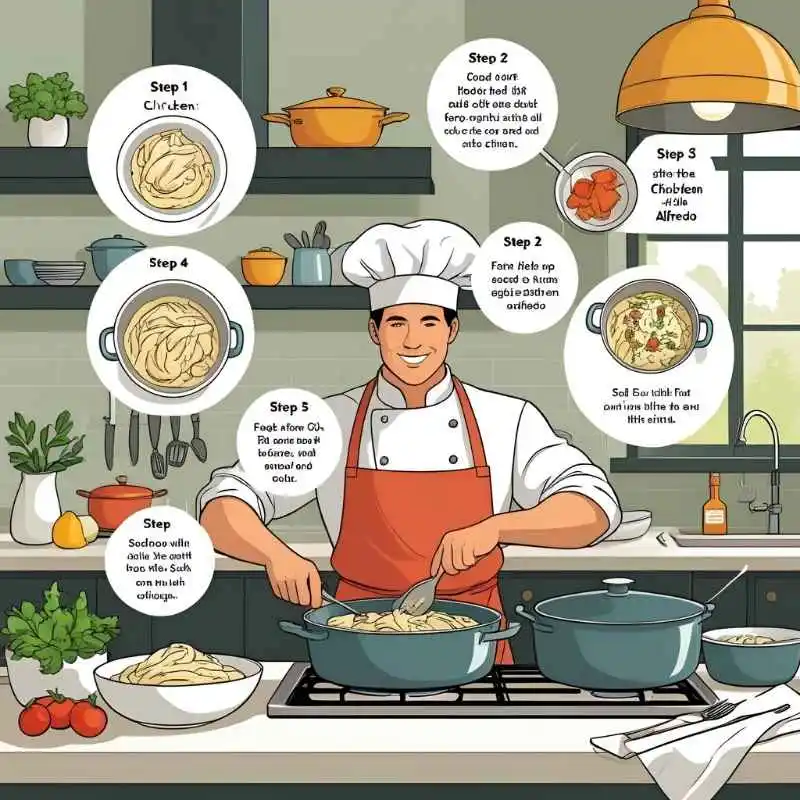
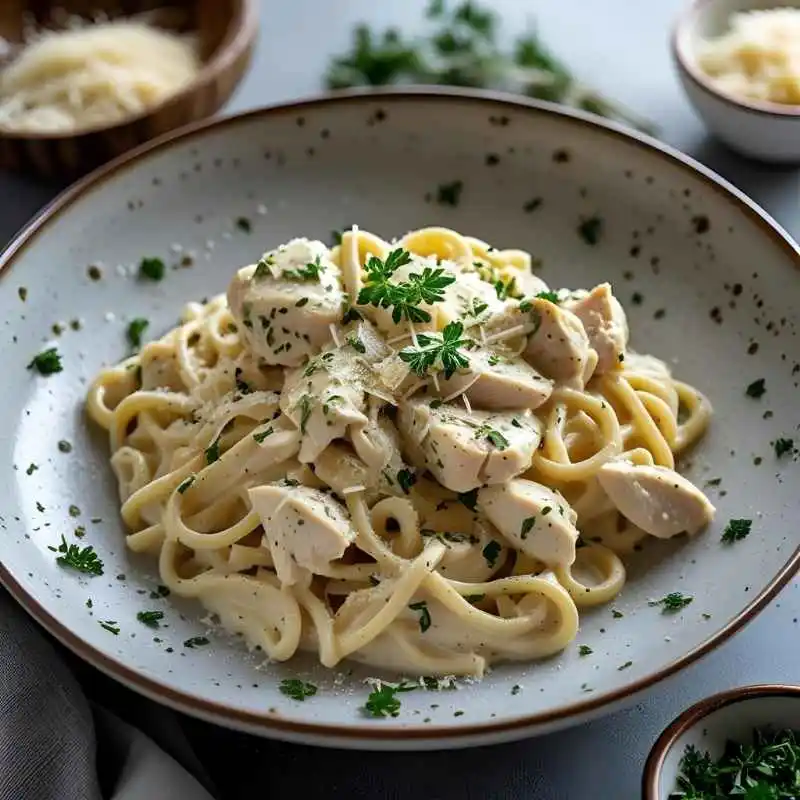
To achieve the perfect consistency, it’s crucial to balance the amount of cream and cheese. Start by melting butter, then add heavy cream, and gradually incorporate Parmesan cheese, stirring constantly. The sauce should be smooth and creamy, coating the pasta evenly.
Troubleshooting Common Sauce Issues
Even with careful preparation, sauce issues can arise. Here are some common problems and their solutions:
- Broken Sauce: If your sauce breaks, it might be due to overheating or insufficient stirring. We’ll cover how to fix this below.
- Incorrect Thickness: Adjusting the thickness can be achieved by adding more cream or cheese for a thicker sauce, or a bit more pasta water for a thinner consistency.
Fixing a Broken Sauce
To fix a broken sauce, remove it from the heat and whisk in a small amount of cold cream or milk. This can help re-emulsify the sauce, restoring its creamy texture.
Adjusting Thickness
If your sauce is too thick, you can thin it out with a little pasta water. Conversely, if it’s too thin, adding more Parmesan cheese or simmering it for a few more minutes can help achieve the desired consistency.
By mastering these techniques, you’ll be able to create a creamy Fettuccine Alfredo sauce that complements your pasta perfectly, making your homemade Chicken Alfredo a true culinary delight.
Cooking Fettuccine to Al Dente Perfection
Achieving the perfect al dente texture in fettuccine is essential for a great Alfredo pasta experience. Cooking fettuccine to the right doneness can make or break your dish, as it provides the necessary texture contrast to the creamy Alfredo sauce.
Water to Pasta Ratio
To start, use a generous amount of water—typically 4 to 6 quarts for every pound of fettuccine. This ratio ensures that the pasta cooks evenly and doesn’t stick together. Using enough water is crucial for preventing the fettuccine from becoming gluey or stuck.
Timing and Testing for Doneness
Cooking time will vary, but a good rule of thumb is to check for doneness a minute or two before the package’s recommended time. Test by biting into a piece; it should have a slight firmness or “bite” to it, indicating it’s al dente. You can also use the timing guidelines on the pasta package as a reference.
Saving Pasta Water for Your Sauce
Before draining, reserve about a cup of pasta water. This starchy water is invaluable for adjusting the consistency of your Alfredo sauce, helping it cling to the fettuccine perfectly. The table below summarizes the key steps in cooking fettuccine to al dente perfection.
| Step | Description |
|---|---|
| 1. Boil Water | Use 4-6 quarts of water per pound of fettuccine. |
| 2. Cook Pasta | Cook until al dente, checking before the recommended time. |
| 3. Reserve Water | Save a cup of pasta water before draining. |
Delicious Variations on Classic Chicken Alfredo
While traditional Chicken Alfredo is a crowd-pleaser, you can easily customize it to suit your taste preferences and dietary needs. The versatility of this dish lies in its ability to be modified with various ingredients, making it a great canvas for creativity in the kitchen.
Adding Vegetables
Incorporating vegetables into your Chicken Alfredo not only adds color but also increases the nutritional value of the dish. Consider adding steamed broccoli, sautéed spinach, or roasted bell peppers to create a more balanced meal. You can also use vegetables like zucchini or carrots to add texture and flavor.
Seafood Alfredo Options
For a seafood twist, you can substitute chicken with shrimp, scallops, or a combination of seafood. This variation is perfect for those who love the ocean’s bounty and want to give their Alfredo a fresh spin. Simply sauté the seafood in garlic butter before adding the Alfredo sauce.
Lighter Alfredo Alternatives
If you’re watching your calorie intake, there are several ways to lighten up your Chicken Alfredo. Use low-fat cream or substitute heavy cream with Greek yogurt to reduce the calorie count. You can also load up on vegetables to make the dish more filling and nutritious.
Gluten-Free and Dairy-Free Adaptations
For those with dietary restrictions, Chicken Alfredo can be adapted to be gluten-free and dairy-free. Use gluten-free pasta and substitute traditional Parmesan with a dairy-free alternative. You can also make a dairy-free Alfredo sauce using cashew cream or nutritional yeast.
By experimenting with these variations, you can enjoy Chicken Alfredo in new and exciting ways while catering to different tastes and dietary requirements.
Serving and Storing Your Chicken Alfredo
When you master how to make chicken alfredo, the final touches can elevate it from a simple meal to a memorable dining experience. Presentation, complementary side dishes, and proper storage are all crucial elements to consider.
Presentation Tips for Impressive Serving
To make your Chicken Alfredo visually appealing, consider the following tips:
- Use a large serving dish or individual plates to showcase the dish.
- Garnish with fresh parsley or basil to add a pop of color.
- Twirl fettuccine around a fork to create an inviting presentation.
Complementary Side Dishes and Pairings
Pairing your Chicken Alfredo with the right side dishes can enhance the overall dining experience. Some suggestions include:
| Side Dish | Description |
|---|---|
| Garlic Bread | A classic Italian staple that pairs perfectly with Alfredo. |
| Roasted Vegetables | Lightly seasoned roasted vegetables add a healthy contrast. |
| Green Salad | A simple green salad with a light vinaigrette can cut the richness. |
Properly Storing Leftovers
To store leftovers, place the Chicken Alfredo in an airtight container and refrigerate within two hours of cooking. When storing, it’s essential to:
- Cool the dish to room temperature before refrigerating.
- Use shallow containers to help the dish cool faster.
- Consume within 3 to 5 days.
Reheating Methods That Maintain Creaminess
Reheating Chicken Alfredo requires care to maintain its creamy texture. Try the following methods:
- Reheat gently over low heat, stirring constantly.
- Add a splash of milk or cream to revive the sauce.
- Avoid microwaving, as it can cause the sauce to break.
By following these tips, you can enjoy your Chicken Alfredo even after reheating, ensuring that it remains a delicious and satisfying meal.
Conclusion: Enjoying Your Homemade Chicken Alfredo
Now that you’ve mastered the chicken alfredo recipe, it’s time to savor the fruits of your labor. This creamy fettuccine pasta dish is sure to become a staple in your household, impressing family and friends alike. By following the steps outlined in this article, you’ve not only created a delicious meal but also gained the confidence to experiment with variations and make it your own.
As you enjoy your homemade Chicken Alfredo, remember the key to its success lies in the quality of ingredients and attention to detail. From selecting the right pasta to achieving the perfect sauce consistency, every step contributes to the dish’s overall flavor and texture. Feel free to get creative with your chicken alfredo recipe by incorporating your favorite ingredients or trying out new variations.
With this chicken alfredo recipe at your fingertips, you’ll be well on your way to becoming a pasta-making pro. So go ahead, take a bite, and relish the rich, creamy goodness of your homemade Chicken Alfredo.
FAQ
What is the best type of pasta to use for Chicken Alfredo?
Fettuccine is the traditional and preferred pasta for Chicken Alfredo due to its flat, wide noodles that hold onto the creamy Alfredo sauce well.
How do I prevent my Alfredo sauce from becoming too thick?
To prevent the Alfredo sauce from becoming too thick, you can adjust its consistency by adding a little pasta water or heavy cream. It’s essential to add these liquids gradually to achieve the desired thickness.
Can I make Chicken Alfredo without heavy cream?
Yes, you can make a lighter version of Chicken Alfredo by substituting heavy cream with alternatives like half-and-half, Greek yogurt, or a mixture of milk and butter. However, keep in mind that the sauce may not be as rich and creamy.
How do I season chicken for Alfredo?
To season chicken for Alfredo, use a combination of salt, pepper, garlic powder, and Italian seasoning. You can also marinate the chicken in a mixture of olive oil, lemon juice, and herbs for extra flavor.
What are some common mistakes to avoid when making Chicken Alfredo?
Common mistakes to avoid include overcooking the pasta, not saving enough pasta water, using low-quality ingredients, and not stirring the sauce constantly, which can lead to a broken sauce.
Can Chicken Alfredo be made gluten-free?
Yes, you can make Chicken Alfredo gluten-free by using gluten-free pasta and being mindful of the ingredients in your Alfredo sauce, as some brands may contain gluten.
How do I reheat Chicken Alfredo without losing its creaminess?
To reheat Chicken Alfredo without losing its creaminess, gently heat it over low heat, stirring constantly, and add a little heavy cream or pasta water if necessary to restore the sauce’s original consistency.
Enjoyed the recipes? We’d love to hear your honest thoughts!😊
There are no reviews yet. Be the first one to write one.

